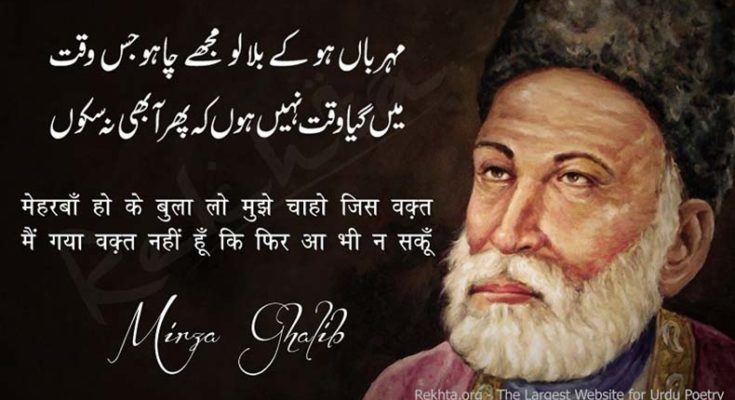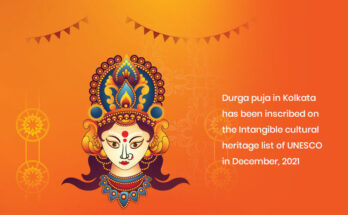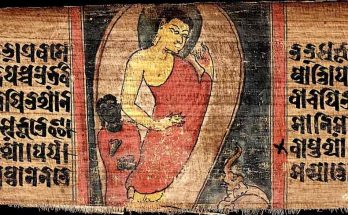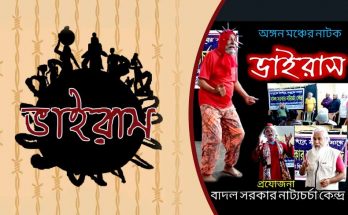Mirza Ghalib was one of the greatest and extremely talented poets of South Asia. Image Courtesy – https://rekhta.org.
Mirza Asadullah Baig Khan was a traditional Urdu and Persian writer from India amid British provincial principles. He is also called by people as ‘Mirza Asadullah Khan Ghalib’, ‘Mirza Ghalib’, ‘Dabir-ul-Mulk’, and ‘Najm-ud-Daula’. The Mughals were veiling and dislodged by the British lastly removed after the annihilation of the Indian resistance in the year 1857. Most remarkably, he composed tons of ghazals during his lifetime, which have following been translated and sung in different ways by different singers. In South Asia, he is known to be one of the most standout and most well known and powerful writers of the Urdu dialect.
Mirza Ghalib was born in the city of Agra, of folks with Turkish families having aristocratic ancestors, presumably on December 27th, 1797. Both his dad and uncle passed on while he was still youthful, and he spent a decent piece of his initial childhood with his mom’s family. This, obviously, started brain research of uncertainties for him. From one perspective, he grew up generally free of any oppressive adult dominance or male domination. This represents him as a free soul he appeared from ahead of schedule adolescence. Then again, this set him in the embarrassing circumstance of being socially and monetarily reliant on maternal grandparents.
The topic of Ghalib’s initial training has frequently befuddled Urdu teachers. Although Ghalib’s primary education had been very poor, it was additionally true that his friend network in Delhi incorporated probably the most famous personalities of his time. There are many pieces of evidence of his compositions, in verse and in exposition, which were recognized by inventive incredibleness as well as by the considerable information of logic, morals, philosophy, established writing, linguistic use, and history that they reflect. It was observed that Mulla Abdussamad Harmuzd was the man who guided Ghalib. Ghalib mentioned his name many times with great respect was, indeed, a genuine individual and a real coach of Ghalib when Ghalib was a young man in Agra. Harmuzd was a Zoroastrian from Iran, changed over to Islam – was a committed researcher of literature, dialect, and religion. He lived in secrecy in Agra while coaching Ghalib, among others.
Read: Explore ‘Oriental Wisdom’ with the golden touch of Indian Institute of Oriental Heritage
As per privileged Muslim custom, he had an orchestrated marriage at 13 years old, however, none of his seven kids survived past earliest stages. This torment has discovered its way into his verse. After his marriage, he settled in Delhi. In one of his letters, he portrays his marriage as the second detainment after the beginning of compulsion, and that was life itself. The thought that life is one persistent excruciating battle that can end just when life itself finishes, is a repeating topic in his verse.
He wrote somewhere to express his emotions filled with grief:
“Runj se khugar hua insaan to mit jaata hai runj
Mushkilein mujh par padi itni ke aasaan ho gayi”
Meaning:
“When a person is habituated of sorrows, then sorrows disappear
So many difficulties fell upon me that everything became easy”.
It was said that Ghalib had a soft spot for drinking and betting. These two indecencies were something that he was really enamored of within his lifetime. Despite the fact that betting was viewed as an offense around then, Ghalib never appeared to have worried about it. He himself said that he was not a strict Muslim in the genuine feeling of the term.
Ghalib was one of the critical court writers in the court of Bahadur Shah Zafar II. He respected Ghalib with the imperial titles of “Dabber-ul-Mulk” and “Najm-ud-daulah”. These titles guaranteed Ghalibs entry into the honorability of Delhi. He suffixed his name with Mirza after Ghalib due to another title that the head added to his honor, “Mirza Nosha”. Bahadur Shah Zafar was an extraordinary artist himself and was exceptionally inspired by composing and presenting verse. He was mentored by Ghalib in the year 1854 and after that Zafar welcomed him to sit in his court as a noteworthy court writer.
He additionally guided Fakhr-ud-Din the eldest child of Bahadur Shah Zafar II. Ghalib was additionally the imperial student of history in the court of Zafar. It is said that Ghalib was slanted towards verse since his initial years and he kept in touch with him lyric interestingly when he was just 11 years old. He knew numerous dialects like Urdu, Persian and Turkish. There was a period in the life of Ghalib when he was at his young age when a voyager originated from Iran to stay in Agra. This explorer was called Abdus Samad and he stayed with Ghalib and his family for a long time. It was assumed that Ghalib learned numerous things from him during this time like Persian and Arabic dialect, rationale, logic, and so on as this voyager was an exceptionally learned man. Ghalib enjoyed his work in the Persian dialect, however, his most popular work was in Urdu. A ton of numerous Urdu artists clarified Ghalib. The primary individual to explain Ghalib’s Urdu verse was Ali Haider Tabatabai from Hyderabad. His verses did not just portray his fizzled cherished and its anguish additionally the “philosophy of life” and “mysticism”.
Read: Chitra Singh fighting a lone battle, despite her husband deserves country’s highest civilian honour.
Mirza Ghalib additionally had an outrageous illicit relationship with a prostitute who was a fanatic of his verse. Actually, one can discover a record of an FIR documented against Ghalib in a police headquarters in Delhi in regards to his issue with the lady. Ghalib never strived for procuring a fair occupation and drove his life on the liberality of his companions or state sponsorship. Despite the fact that nobody gave him due significance then, acclaim came much later. Today, he is the most expounded on the writer and the most read artist in Urdu. On February fifteenth, 1869, this awesome writer inhaled his last.
The most versatile writer of Urdu poetry is still to be explored more and more by the community or poetry lovers. We, the people of modern society with high-end technological devices feel sorrow that we could not give him that much focus as he deserved. At the same time, the people of India also could not give him the value of his amazing talent within his lifetime.
We would like to give him a great salute with his writings:
“Hazaaron khwahishen aisi ke har khwahish pe dam nikle
Bohat niklay mere armaan, lekin phir bhi kam nikle
Daray kyon mera qaatil? kya rahega us ki gardan par?
Voh khoon, jo chashm-e-tar se umr bhar yoon dam-ba-dam nikle”
Meaning:
“A thousand desires such as these that each desire takes a lifetime. I have had many a desire, but they were all but few.
For people who dream as I do, one lifetime is not enough to fulfill all the dreams, to live all the desires.
Why should my killer (lover) be afraid? No one will hold her responsible
For the blood which drips from my eyes for my entire life”.





